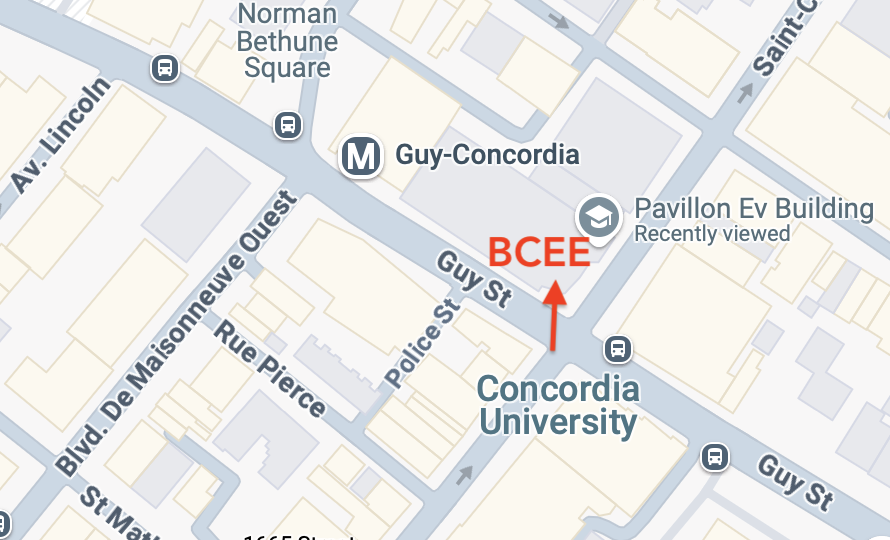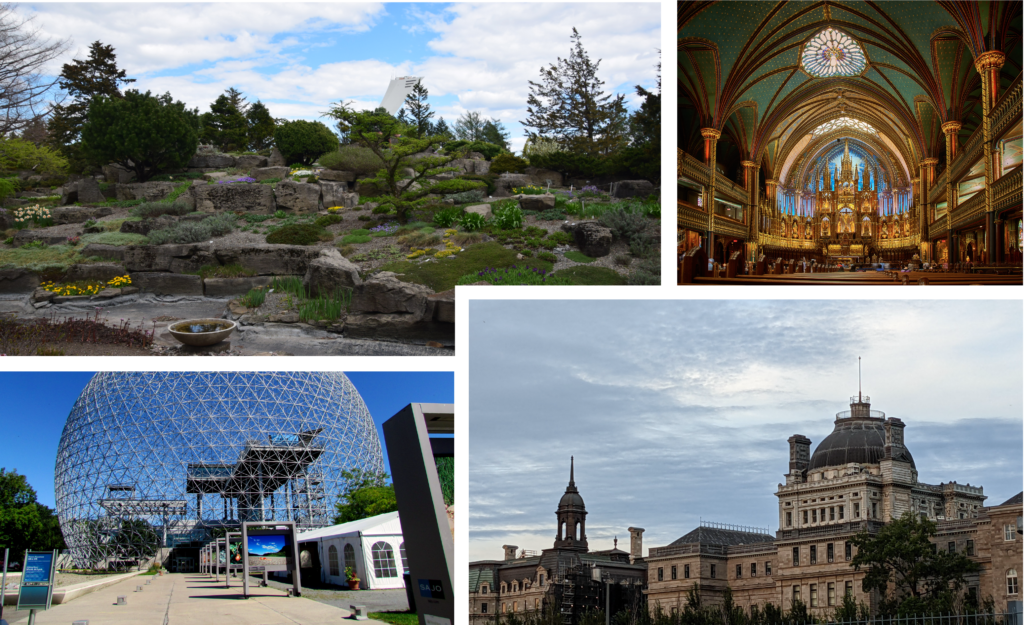
The 2025 GHP Meeting will take place at:
Concordia University
Department of Building, Civil and Environmental Engineering(BCEE)
1515 Ste. Catherine St. W.
Montreal, QC H3G 2W1, Canada

There are many types of accommodations in different price ranges in the vicinity of the meeting venue. Please use your own preferred accommodation booking method.
Getting to Montreal by air
Flights arrive at the the Montréal-Trudeau International Airport (YUL). From the airport you can travel to Montreal by:
1) Taxi
fare to downtown Montréal is about CAD40, payable by cash or credit card, or by
2) STM Public bus
Bus number 747 runs 24 hours per day, 7 days a week between the airport and downtown Montreal. One-way cash fare is CAD10 payable in Canadian coins (no bills) or by fare card, which you can buy at the airport’s international arrivals exit.
Bus number 747 stops at two different metro stations that will connect you to Concordia. If you get of the bus at:
* Lionel-Groulx metro station: take the green line direction Honoré-Beaugrand.
* Berri-UQAM metro station: take the green line direction Angrignon.
Get off the metro at Guy-Concordia station, and take the Guy Street (rue Guy) exit.
See the metro network map and for additional information about public transportation go to Getting around in Montreal.
Getting to Montreal by train
If you’re traveling to Montreal from Ottawa, Toronto or beyond, consider taking the train. You’ll arrive in Montreal at Gare Centrale, which is about a 16 minute walk or an eight minute taxi ride to BCEE. Using the metro system is also an option:
* Start at the Bonaventure metro station on the orange line direction Côte-Vertu
* At the Lionel-Groulx metro station, transfer to the green line direction Honoré-Beaugrand
* Exit at Guy-Concordia station and take the Guy Street (rue Guy) exit.
See the metro network map and for additional information about public transportation go to Getting around in Montreal.
Getting around in Montreal
Public transportation is an affordable way to get around Montreal. The metro (subway) system is clean, safe and fast. With just four lines connecting the downtown center to major tourist sites, bus stops and train stations it’s an easy way to get around in Montreal. The metro operates daily from 5:30 a.m. to 1 a.m. (1:30 a.m. on Saturdays). The average wait time between trains is eight minutes and three minutes during rush hour.
The OPUS card is a smart card on which you can charge all Zone A (Greater Montréal area) transit fares, with the exception of group fares, which are available only on tickets. More information about public transportation tickets, point of sales, etc. can be found here. Bus and metro route maps are available at https://www.stm.info/en/info/networks/maps
Come experience Montréal like a local by hopping on a bike. Montreal boast more than 700 km of bike paths. You can rent a bike, bringing your own or try out Montréal’s BIXI system, a bike sharing system throughout the city. Visit the Guide to all things biking in Montreal for detailed information about routes, tours, rentals, etc.
Montréal is an island. Water taxis run between the Old Port of Montréal and Parc Jean-Drapeau, Longueuil, and other points of interest along the St. Lawrence River.
Rideshare with Uber and the traditional taxi cab is available in Montreal.
For detailed information about how to get around in Montreal visit Tourisme Montréal.
River Shuttle Network, courtesy of Société de transport de Montréal (STM)
Most travelers need a visitor visa or an Electronic Travel Authorization to travel to Canada. You may also need one if you’re transiting through a Canadian airport on your way to your final destination.
The entry document you need depends on:
To find out if and the type of visa you need to travel to Canada, click here.
Montreal is the largest city of Quebec and second largest city in Canada. Founded in 1642 as Ville-Marie, or “City of Mary”, it is renamed after the triple-peaked Mount Royal around which the early settlement was built. French is the official language in Montreal. Most people are bilingual, however, and speak both English and French. The city is composed of 19 large boroughs and are subdivided in neighborhoods. Downtown, the historic district of Old Montreal, Chinatown, the Gay Village, and other neighborhoods of interest are located in borough Ville-Marie.
As you can expect from a large and vibrant city, there is a lot to see and do in Montreal. From culture, art to festivals, nature and other recreational activities. Montreal has something for everyone. Just to name a few:

For more ideas and other practical information, visit Montreal Tourism.
Images (left-right; top-down)
Mig Gilbert – Montreal Botanical Gardens
Pedro Szekely – Notre-Dame Basilica
Bobistraveling – Biosphere Montreal
Eden, Janine and Jim – Old Montreal
Call 911 in case of all type of emergencies (health, fire, law enforcement, etc.).
For non-urgent service check out the SPVM website or contact (+1) 514 280-2222 where a police officer can be reached at all times.
All attendees and participants are expected to conduct themselves with integrity and in a manner that is professional, respectful, tolerant and responsible. A zero-tolerance approach will be applied to any form of discrimination or harassment, including but not limited to sexual harassment and bullying.
Discrimination is any unfair treatment or arbitrary distinction based on a person’s race, religion, nationality, ethnic origin, sexual orientation, disability, age, language, social origin or other status. Discrimination may be an isolated event affecting one person or a group of persons similarly situated or may manifest itself through harassment or abuse of authority.
Harassment is any improper and unwelcome conduct that might reasonably be expected or be perceived to cause offense or humiliation to another person because of inter alia, an individual’s gender, gender identity and expression, sexual orientation, disability, physical appearance, ethnicity, national origin, age, or religion. Bullying is unwelcome, aggressive behavior involving the use of influence, threat, intimidation, or coercion to dominate others in the professional environment.’
Harassment or bullying may take the form of words, gestures or actions which tend to annoy, alarm, abuse, demean, intimidate, belittle, humiliate or embarrass another or which create intimidating, hostile or offensive professional environment.
Sexual harassment is a specific type of prohibited conduct. It is any unwelcome conduct of a sexual nature. Sexual harassment may be any conduct of a verbal, including via electronic or telephonic means, nonverbal or physical in nature and may occur between persons of the opposite or same sex.
In the event that a participant of this conference, feels that an issue has arisen regarding disrespectful treatment, harassment bullying or discrimination, regardless of whether it rises to the level of breach of this conduct, the member or event participant is encouraged to discuss it in confidence, with anyone in the list below, as appropriate:
or send a message to contact@gewexevents.org with your contact information and a short description of the issue.
In the event of a clear or perceived breach of the code of conduct, it may be reported in writing to the Director of the International GEWEX Project Office, or the Chair(s) of the GEWEX SSG. Once this is received, a GEWEX SSG member will be appointed as point of contact, who will first discuss with the complaint on how they wish to proceed.
All reports and allegations of breaches to this code of conduct will be handled sensitively and in confidence. The immediate priority will be to protect the privacy of the person(s) exposed to the breach of conduct and the need for further action will be assessed carefully on a case-by-case basis.
The organizers cannot accept liability for personal accident, loss, or damage to private property, which may be incurred as a result of participation in the 2025 GHP Meeting . Participants are, therefore, advised to arrange appropriate insurance coverage.
The organizing committee will not accept liability for damages of any nature sustained by participants or loss of or damage to their personal property as a result of any event.